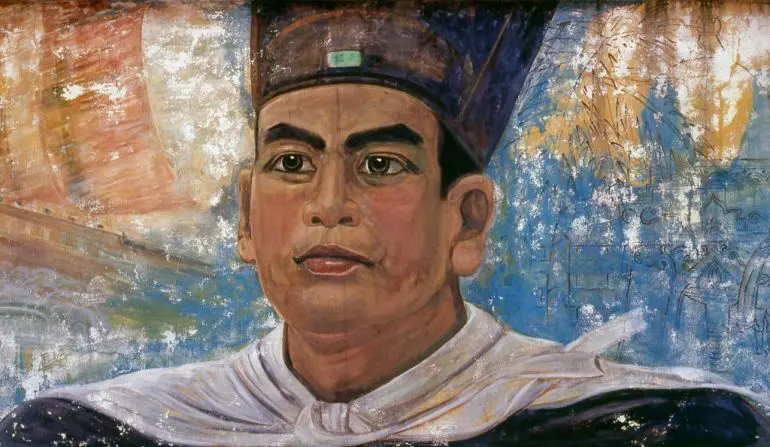Decades before renowned European explorers like Christopher Columbus, Amerigo Vespucci, Bartolomeu Dias, and Pedro Álvares Cabral embarked on their famed voyages during the Age of Discovery, admiral Zheng He had already set out on some of the most daring and extensive maritime expeditions in history.
Between 1405 and 1433, Zheng He led seven epic voyages across the South China Sea and the Indian Ocean. These expeditions, involving hundreds of ships and tens of thousands of men, were virtually unparalleled in scale and ambition.
The Zheng He voyages showcased the technological, navigational, and diplomatic achievements of China’s Ming dynasty, and they significantly impacted global trade patterns and cultural exchanges. His journeys laid the groundwork for the interconnected global trade system that developed in the centuries to follow.
The story of Zheng He and the Chinese treasure ship is legendary in China – he is widely celebrated as the most distinguished explorer and adventurer in the annals of Chinese maritime history. This is the remarkable story of the voyages of Zheng He.
The Early Life of Zheng He

A modern wall painting of Zheng He (Credit: Pictures from History / Contributor via Getty Images)
Originally named Ma He, Zheng He was born in 1371 in the southwestern Chinese province of Yunnan. His early life was marked by significant upheaval. At the age of ten, during the Ming Dynasty’s military campaign in Yunnan, he was captured and subsequently entered into imperial service. Despite these early challenges, Zheng He rose through the ranks, demonstrating remarkable intelligence and loyalty. Crucially, he made influential friends while in the service of Zhu Di, who became the Yongle Emperor, the third emperor of the Ming dynasty. It was these connections which eventually led to him becoming one of the most famous maritime explorers in Chinese history.
Zheng He & Yongle
When Zhu Di successfully took the throne and became Emperor Yongle in 1402, Zheng He’s position in the court was set. The emperor, eager to assert Ming China’s power and prestige, initiated a series of ambitious naval expeditions and appointed Zheng He to lead these voyages. This decision marked a significant turning point, transitioning the young man from a court advisor to Admiral Zheng He, the commander of what would become some of history’s most extensive and far-reaching maritime expeditions.
Under Yongle’s patronage, Zheng He led seven grand voyages between 1405 and 1433, reaching far beyond the traditional routes of commerce, developing diplomatic relationships, permanently reshaping Chinese life, and establishing Zheng He as a legendary figure in the annals of exploration.
The Seven Voyages of Zheng He

A giraffe brought to the court of Emperor Yongle (Credit: Pictures from History / Contributor via Getty Images)
Each of the Zheng He voyages was a complex undertaking, involving not just exploration but also diplomatic missions, trade, and the demonstration of Chinese naval might. They were also a way for the emperor to legitimise his position in the international political arena.
These expeditions were unprecedented for their scale and impact. They greatly enhanced the Ming dynasty’s influence across the Indian Ocean and established China as a major maritime power.
The Ships

Full-sized replica of one of Admiral Zheng He's ships (Credit: ROSLAN RAHMAN / Staff via Getty Images)
There remains some debate as to the size of Zheng He’s ships. The Chinese treasure ship described by Chinese chroniclers was believed to be 127 metres long and 52 metres wide. It is thought it could carry somewhere between 500 and 1,000 people. This would have been double the length of any contemporary wooden ship, and in fact bigger than later ships such as the HMS Victory, launched in the eighteenth century. Indeed it would have therefore been similar in size to nineteenth century iron-hulled steamers.
Yet some scholars doubt the veracity of these claims – written three centuries later – suggesting they were probably no more than 70m in length.
In addition to the famous Chinese treasure ship, the Zheng He voyages also included equine ships carrying horses and repair materials, supply ships carrying food and medical supplies, transport ships, and warships.
The First Voyage: 1405-1407
Believed to have consisted of over 300 ships and almost 28,000 men, the cargo, according to a contemporary writer, included ‘imperial letters to the countries of the Western Ocean and with gifts to their kings of gold brocade, patterned silks, and coloured silk gauze, according to their status’. The first of the voyages of Zheng He took him through Southeast Asia, the Horn of Africa and parts of the Arabian Peninsula. It was largely used to establish a Chinese presence, show off the might of their naval power, and to create tributary relationships.
The Second & Third Voyages: 1407/8-1409 and 1409-1411
The second and third voyages of Zheng He were similar in size and purpose to that of the first. The fleet stopped in places like Java and the coastal cities of Siam (modern-day Thailand), India’s Malabar Coast and the Malay Peninsula. They were, like the first voyage, designed to develop and strengthen diplomatic ties, establish new – and expand existing – tributary relationships, and also to deal with disruptions encountered in previous voyages, including one on Ceylon (present-day Sri Lanka).
The Fourth Voyage: 1412-1415
The fourth voyage – believed to be the largest of all including close to 29,000 men and over sixty Chinese treasure ships – took Zheng He further than he had been previously. As well as the Malay Peninsula, modern-day Sri Lanka, and Calicut in India, he carried on to the Maldives, Hormuz in the Persian Gulf and, it is believed, the eastern coast of Africa. He traded spices and silks with foreign rulers and returned with diplomatic envoys from a number of countries he visited.
The Fifth Voyage: 1417-1419
One of the primary purposes of the fifth voyage was for Zheng He to return the envoys from whence they came, along with imperial letters and gifts for the various rulers in acknowledgement of them sending representatives to China. The fifth voyage is said to have returned to China with ivory, as well as zebras, camels, ostriches and even giraffes.
The Sixth Voyage: 1421-1422/3
Smaller in size than previous voyages, the sixth voyage was similar in route to the previous trip and visited a number of previous locations. Around two years after Admiral Zheng He returned, the Yongle Emperor died. While Zheng He remained at court, all naval expeditions were suspended and it would be almost a decade before he took his final voyage under the Xuande Emperor.
The Last Voyage of Zheng He

Replica of Zheng He's treasure ship in Nanjing (Credit: China Photos / Stringer via Getty Images)
A huge fleet of Chinese treasure ships set out in 1431 for what would be the last hurrah of Zheng He.
By this time he was around sixty and in failing health, but the lure of the open ocean was too good to refuse. The seventh voyage reached as far west as Hormuz and contemporary sources suggest they visited at least seventeen or even as many as twenty countries. This was to be his final voyage.
There are two competing theories as to the date of the death of Zheng He.
The most commonly accepted theory is that Zheng He died in 1433, either at sea or shortly after his fleet returned to China. This version is widely cited in historical documents and is the one most historians lean towards due to its consistency with the timelines of his voyages and historical records from the Ming dynasty.
A less common but still significant theory suggests that Zheng He died in 1435, two years after the last voyage. This theory is based on some later historical texts and inscriptions that suggest he might have lived beyond the completion of his seventh voyage. However, this theory is not as widely accepted due to less supporting evidence compared to the 1433 theory.
The exact circumstances and location of his death remain uncertain due to the lack of definitive historical records. Despite this, his legacy as a great navigator and diplomat endures, and the voyages of Zheng He continue to be celebrated for their remarkable achievements in maritime history.
The Enduring Legacy of Zheng He

Historic world map (Credit: Photo 12 via Getty Images)
The Zheng He voyages stand as a monumental chapter in the annals of maritime history, showcasing the prowess and ambition of the Ming Dynasty’s naval capabilities.
His journeys surpassed the maritime boundaries of his time, and fostered unprecedented cultural and economic exchanges between China and the rest of the world. The expeditions, marked by their scale, sophistication, and diplomatic finesse, not only redefined global trade routes, but also left an indelible mark on the history of international relations and cross-cultural interactions.
The story of Zheng He continues to inspire and intrigue scholars, and is a reminder of the complexity of the vast, interconnected tapestry of human history.












